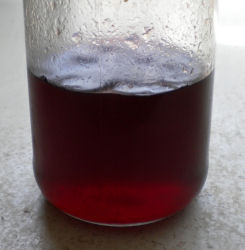Redcurrant Jelly

Redcurrant jelly is traditionally eaten with roast lamb in Britain. This may seem odd, but the tartness of the jelly helps with the greasiness of the lamb. In Britain, a jelly is a type of jam, but it is made of the fruit juice, without any pips.
Ingredients
red currants
water
sugar
| |
Equipment
saucepan
wooden spoon
sieve
plate
sugar thermometer (optional)
two jam jars with lids
| |
preparation time:
heat red currants to extract juice
heat juice and sugar until it jells ()
|
Cooking process
- You need to sterilise the jam jar. Wash it in fairly hot water, then fill them with hot (but not boiling) water. Glass will break if you suddenly put too hot water (or jam) in it, but the warm water helps to raise its temperature which makes it safer. Make sure the lid is immersed in hot water as well.
- Put the red currants in a saucepan and heat them until the juice starts to flow well. Then sieve out the juice. If you have a muslin cloth, you could use that instead.
- The suggested amount of red currants should produce about of juice. Add of sugar per of juice.
Put the juice and sugar in the saucepan and heat them until the gelling point is reached. This is higher than the boiling point of water, so first you need to heat it until you see no more steam (which takes some time). The try dribbling a bit of the jelly onto a cold plate. Tilt the plate, or run your finger through it (careful - it might still be hot!) If wrinkles form, then it is gelling. (If you have a sugar thermometer, then the gelling point is ). Immediately take it off the heat or it might start turning into toffee!
- Empty the jam jars of hot water and carefully pour the jelly into the jam jar. Since the jam jar will be hot from the water, it shouldn't mind the hot jelly. The jelly will be hotter than boiling water, and will stick to you if you're silly enough to pour it on yourself, so be careful! I tend to do all this in the sink, so if it slops over the edge of the jar, it can easily be washed away. Now screw on the tops (remember that everything will be quite hot!).
Other ideas
- Some people put circles of paper on top of the jelly. This is to stop mould. This jelly has a fair amount of sugar in it, which helps to preserve it.
© Jo Edkins 2008 -

